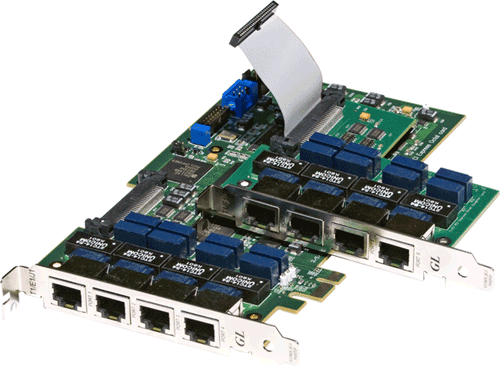Newsletter: GL Announces T1E1 Quad & Octal Analysis & Emulation Hardware
Welcome to a February 2012 issue of GL Communications' Newsletter providing information and insight into our latest T1 E1 Quad and Octal Analysis and Emulation Boards.

Overview
GL's Octal & Quad T1 E1 boards are high-density boards that provide Four (4) or Eight (8) RJ-48 T1 E1 ports and multiples thereof. For example, configurations of 8, 12, 16, ...64 T1 E1s in a single rack are possible.

Important Applications / Features:
- T1 or E1 interfacing - Software Selectable
- TDM, ISDN, SS7 - High Density Voice
- VoIP, Frame Relay, Multi-Link Frame Relay, PPP, IMA, and Multi-Link PPP, HDLC
- Most all "special applications" are available for Quad and Octal T1 E1 cards
- Call Recording, Generation, and Monitoring for hundreds to thousands of calls in one platform
- Windows® and Linux Drivers for Open Source Applications
- Media (VoIP) Gateway, IP PBX, and IVR Applications i.e. Asterisk (TM)
- Router with Multi T1 E1 WAN Interfaces i.e. ML-PPP (Multi Link PPP)
- PCI Express x1 Lane/Board
- "Cross-Port Through" and "Cross-Port Transmit" Modes - these configurations make cabling with Drop/Insert and Fail-Safe Inline Monitoring very easy
- High Density and High Speed - The boards (with Direct Memory Access) are significantly faster and significantly more efficient
- Octal boards are compatible with dual, quad, and higher core motherboards and software that simulate dual and quad cores (hyper-threading)
The cards are available with user-friendly GUI for Windows® XP and Windows® 7 operating systems with support for almost all existing T1 E1 Analyzer applications including Comprehensive Analysis / Emulation of Voice, Data, Protocol, Digital, and Echo Testing.
Comparison and advantages of the new Quad and Octal Cards over Dual T1 E1 Universal Cards are given in the following table.
| Feature | Universal Dual T1 E1 Boards | Quad, Octal T1 E1 Boards |
|---|---|---|
| Number of Ports | 2 | 4, 8 |
| PCI Slot Type | Uses a PCI Bus / Connector | Uses a PCI Express x1 Bus / Connector |
| Output Frequency Offset | Each port can be individually set with an output frequency offset | A single frequency offset which is applied to all 8 ports |
| Pulse Mask Application | Supported | Not Supported |
| Jitter Measurement | Supported | Not Supported |
| External Clock Mode | Supported | No clock port connector |
| VF Drop and Insert | Supported | No VF connectors; Digital Drop/Insert supported |
| Speaker (on board) | Supported | No speakers |
For the comprehensive information on the hardware, you can refer to Octal & Quad T1 E1 Analysis and Emulation Hardware web page.
 Back to Newsletter Index Page
Back to Newsletter Index Page